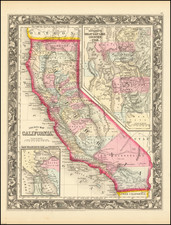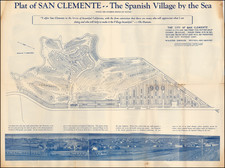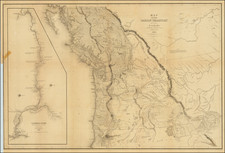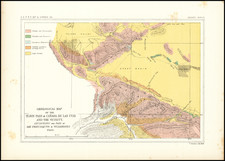Metsker's Map of Kern County California, executed by Thomas C. Metsker and Mark F. Metsker and published in Tacoma & Seattle, Washington in 1970, provides a detailed cartographic depiction of Kern County, prominently featuring an oil derrick, a symbol of the region's significance in the oil industry.
In the latter half of the 20th century, Kern County emerged as one of the primary hubs of oil production in the United States. Its landscapes were dotted with derricks, signifying the economic lifeblood of the region. By 1970, this nexus between Kern County and oil exploration had solidified, making the county a focal point for industrial, economic, and geographical studies, particularly in the context of California's broader energy landscape. The oil derrick behind the title serves as a visual reminder of this relationship, accentuating the map's relevance to this historical period.
The intricacies of the map's legend denote a thorough representation of the county's features: from major interstate highways like the I-5 and U.S. Highway 99 to minor trails and lookout points. The differentiation between types of roads—paved, oil mat, dirt, and even inferior roads—offers a comprehensive view of the region's infrastructural development. Moreover, markers for schools, ranger stations, camps, mines, and elevations provide a broader perspective, shedding light on the socio-economic and topographical dynamics of the area.
Additionally, the map encompasses various other significant boundary demarcations, such as the National Forest Boundary, land grant lines, and judicial district boundaries. These, paired with the more routine markers for railroads, intermittent creeks, and game refuge boundaries, highlight the map's utility as a multi-dimensional tool, capturing both the county's natural resources and its administrative delineations.














![Parts of E. California and S. E. Nevada, N.W. Arizona and S.W. Utah __ Atlas Sheet No. 66 [Shows Las Vegas!]](https://storage.googleapis.com/raremaps/img/small/92030.jpg)

![[Nevada and parts of California, Utah and Arizona] Explorations and Surveys South of Central Pacific R.R. . . . Preliminary Topographical Map Map Embracing in Skeleton a Portion Only of the Notes from Surveys . . . 1871 (with original text)](https://storage.googleapis.com/raremaps/img/small/82964.jpg)